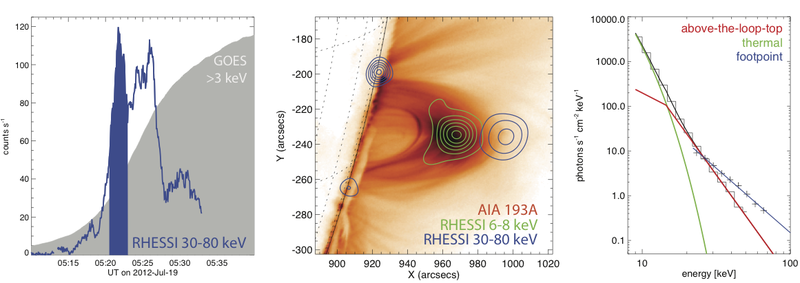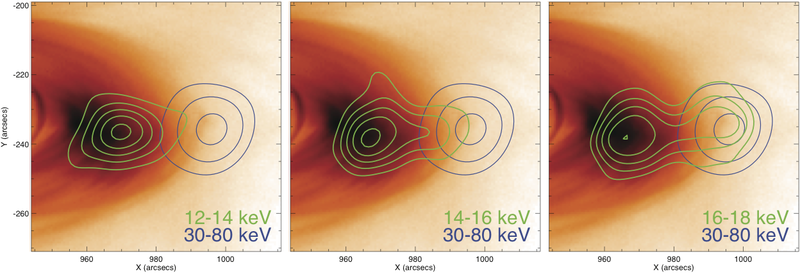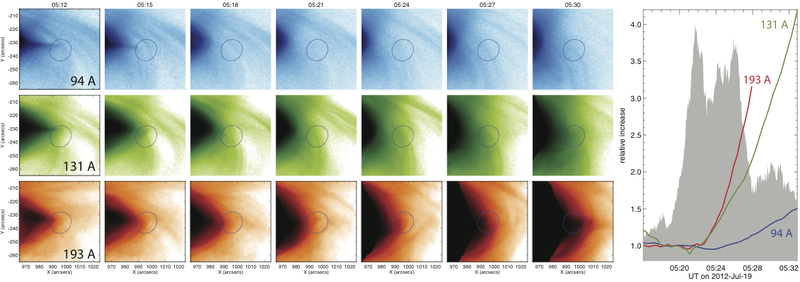Acceleration-region Densities
From RHESSI Wiki
(Figures uploaded) |
(Draft Intro) |
||
| Line 11: | Line 11: | ||
== Introduction == | == Introduction == | ||
| + | |||
| + | RHESSI has abundantly confirmed the importance of energetic electrons in solar flares. | ||
| + | These electrons radiate via non-thermal [http://hyperphysics.phy-astr.gsu.edu/hbase/quantum/xrayc.html bremsstrahlung], as detected and imaged in the hard X-ray (HXR) spectrum. | ||
| + | Ultimately the energy comes from a reservoir created by the intense magnetic field in the corona, typically near a magnetic [http://www.scholarpedia.org/article/Solar_activity active region]. | ||
| + | Flare structures reflect the dynamics of the magnetic field as it restructures itself to create the flare (and, if powerful enough, to launch a | ||
| + | [http://solarscience.msfc.nasa.gov/CMEs.shtml coronal mass ejection]. | ||
| + | The first clear mapping of these processes via hard X-ray imaging came from the [http://en.wikipedia.org/wiki/Yohkoh Yohkoh] satellite, which detected the often-discussed "Masuda flare" [Ref. 1]. | ||
| + | The interesting feature of this flare was the location of the hard X-ray emission: it was from a coronal region ''above'' the hot (soft X-ray) loops that virtually define a flare nowadays, rather than in the loops themselves. | ||
| + | This region of the corona had no identifying features, other than the hard X-ray emission, but this was so powerful that the phenomenon immediately was taken to | ||
| + | reflect the primary energy release of the flare, and its particle acceleration. | ||
| + | |||
| + | The Masuda flare was in 1992 (SOL1992-01-13, to give its official name), and since the launch of RHESSI in 2002 we have gradually been coming to understand more about the physics involved. | ||
| + | Clean examples of "above-the-loop-top" emission, as in the singular case of the Masuda flare, have been rare, and the event discussed here | ||
| + | (SOL2012-07-19T05:58, [http://www.swpc.noaa.gov/today.html M7.7]) is one of the best in the RHESSI database, and it had copious supporting observation - specifically, from [http://aia.lmsal.com/ SDO/AIA] with its wonderful images of flare structures as seen in thermal emissions. | ||
| + | |||
| + | == SOL2012-07-19T05:58 == | ||
[[File:205f1.png|center|800px|Figure 1: | [[File:205f1.png|center|800px|Figure 1: | ||
]] | ]] | ||
| - | + | ||
[[File:205f2.png|center|800px|Figure 2: | [[File:205f2.png|center|800px|Figure 2: | ||
]] | ]] | ||
| Line 25: | Line 41: | ||
== References == | == References == | ||
| - | [1] [http://adsabs.harvard.edu/abs/2010ApJ...714.1108K Measurements of the Coronal Acceleration Region of a Solar Flare} | + | [1] [http://adsabs.harvard.edu/abs/1994Natur.371..495M "A loop-top hard X-ray source in a compact solar flare as evidence for magnetic reconnection"] |
| + | |||
| + | [2] [http://adsabs.harvard.edu/abs/2010ApJ...714.1108K "Measurements of the Coronal Acceleration Region of a Solar Flare"} | ||
Revision as of 14:52, 5 August 2013
| Nugget | |
|---|---|
| Number: | 205 |
| 1st Author: | Säm Krucker |
| 2nd Author: | Marina Battaglia |
| Published: | August 5, 2013 |
| Next Nugget: | TBD |
| Previous Nugget: | Implosion and Oscillation |
| List all | |
Contents |
Introduction
RHESSI has abundantly confirmed the importance of energetic electrons in solar flares. These electrons radiate via non-thermal bremsstrahlung, as detected and imaged in the hard X-ray (HXR) spectrum. Ultimately the energy comes from a reservoir created by the intense magnetic field in the corona, typically near a magnetic active region. Flare structures reflect the dynamics of the magnetic field as it restructures itself to create the flare (and, if powerful enough, to launch a coronal mass ejection. The first clear mapping of these processes via hard X-ray imaging came from the Yohkoh satellite, which detected the often-discussed "Masuda flare" [Ref. 1]. The interesting feature of this flare was the location of the hard X-ray emission: it was from a coronal region above the hot (soft X-ray) loops that virtually define a flare nowadays, rather than in the loops themselves. This region of the corona had no identifying features, other than the hard X-ray emission, but this was so powerful that the phenomenon immediately was taken to reflect the primary energy release of the flare, and its particle acceleration.
The Masuda flare was in 1992 (SOL1992-01-13, to give its official name), and since the launch of RHESSI in 2002 we have gradually been coming to understand more about the physics involved. Clean examples of "above-the-loop-top" emission, as in the singular case of the Masuda flare, have been rare, and the event discussed here (SOL2012-07-19T05:58, M7.7) is one of the best in the RHESSI database, and it had copious supporting observation - specifically, from SDO/AIA with its wonderful images of flare structures as seen in thermal emissions.
SOL2012-07-19T05:58
Conclusion
References
[1] "A loop-top hard X-ray source in a compact solar flare as evidence for magnetic reconnection"
[2] [http://adsabs.harvard.edu/abs/2010ApJ...714.1108K "Measurements of the Coronal Acceleration Region of a Solar Flare"}
| RHESSI Nugget Date | 5 August 2013 + |
| RHESSI Nugget First Author | Säm Krucker + |
| RHESSI Nugget Index | 205 + |
| RHESSI Nugget Second Author | Marina Battaglia + |


